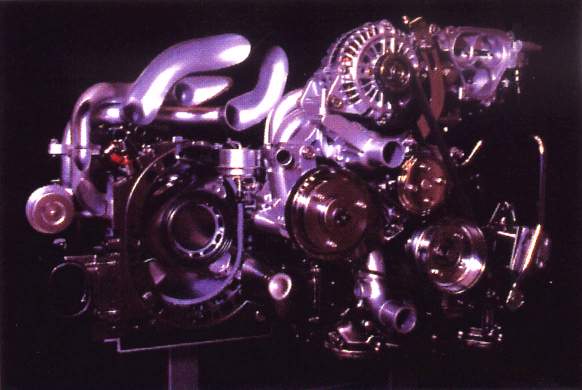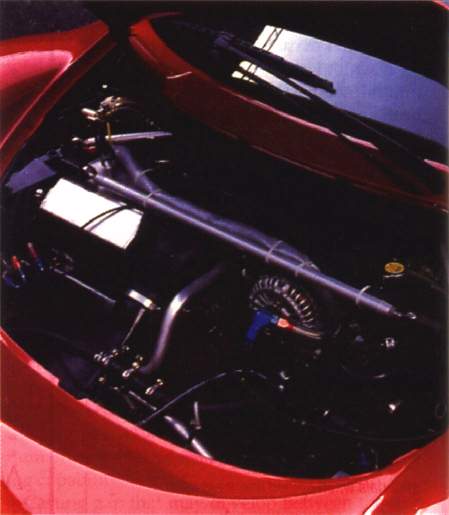
side-exhaust twin-rotor Wankel engine produces high
power and torque, while assuring good fuel economy.
reprinted from Automotive Engineering, January 1996
Mazda's side-intake, side-exhaust rotary engine prototype
 |
| Mazda's prototype, naturally aspirated, side-intake, side-exhaust twin-rotor Wankel engine produces high power and torque, while assuring good fuel economy. |
Mazda has been developing a significant variant of the evergreen, type 13B, twin-rotor Wankel engine. Mazda's series-production rotaries have always employed side intake ports and peripheral ports. In the prototype engine, both intake and exhaust ports are located in the side-housings.
Because of the rotary's geometical characteristics, i.e., ports are opened by the rotor's movement, the peripheral exhaust port opens and closes quite abruptly. In the production 13B, it opens at 75° BBDC and closes at 45° ATDC. With the primary and secondary intake ports opening at 32° ATDC, there is an overlap between the exhaust closing and the intake opening. With the side exhaust porting, overlap is completely eliminated. Following are comparisons of the port timings of the two types:
| Base engine type 13B twin-rotor, single chamber capacity 654 cc |
|||
|---|---|---|---|
| Side-intake, peripheral intake port |
Side-intake and exhaust port |
||
| Primary intake | opens | 32° ATDC | 32° ATDC |
| closes | 40° ABDC | 40° ABDC | |
| Secondary intake | opens | 32° ATDC | 32° ATDC |
| closes | 30° ABDC | 30° ABDC | |
| Aux. intake | opens | 45° ATDC | 45° ATDC |
| closes | 80° ABDC | 80° ABDC | |
| Exhaust | opens | 75° BBDC | 50° BBDC |
| closes | 48° ATDC | 23° BTDC | |
Mazda discovered that the side-exhaust port engine's fuel consumption has been significantly improved, because of its ability to run on leaner air/fuel ratios, of improved internal EGR ratio, and of high combustion stability over the entire load range. The side-exhaust engine has lower HC emissions, 35-50% less than those from the peripheral-port engine.
 |
| The new twin-rotor engine sits well aft of the front wheel axle-line, in a true "central midships" manner. It employs dry sump lubrication. |
The experimental engine, naturally aspirated and fuel-injected, is promising in its performance, producing 164 kW (JIS) at 7500 rpm and maximum torque of 216 N·m at 6000 rpm.
The engine adopts dry-sump lubrication, which allowed its lower and rearward installation in a concept 2+2 sports coupe, Mazda describing its position as "central midships." The engine's output shaft height has been lowered by 55 mm, and its position pushed back by 205 mm, placing it well aft of the front-wheel axle line. This enabled Mazda designers to slant the car's nose sharply. The engine's position has achieved an extremely low polar moment of inertia, providing the concept car with outstanding dynamics, reports Mazda.